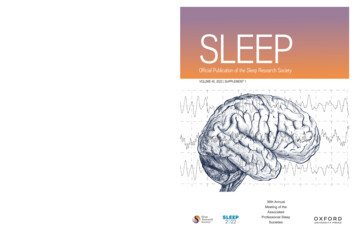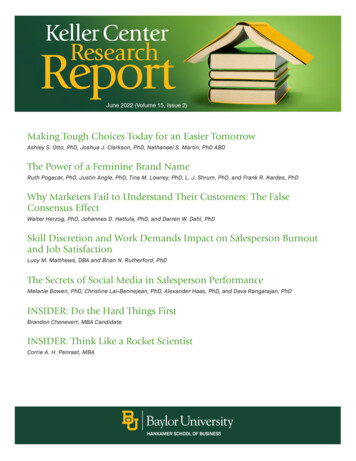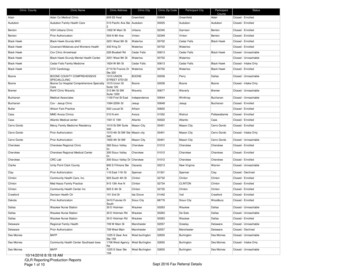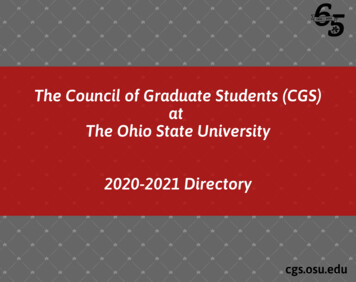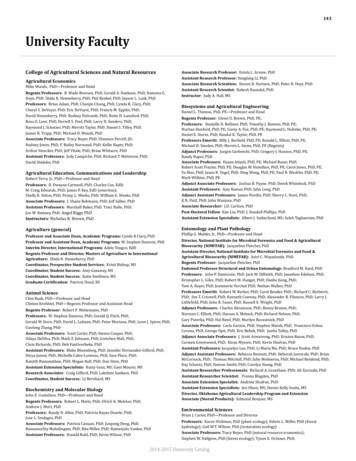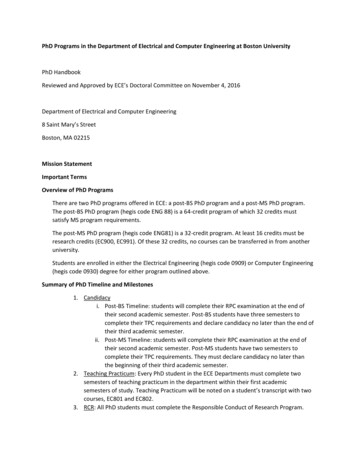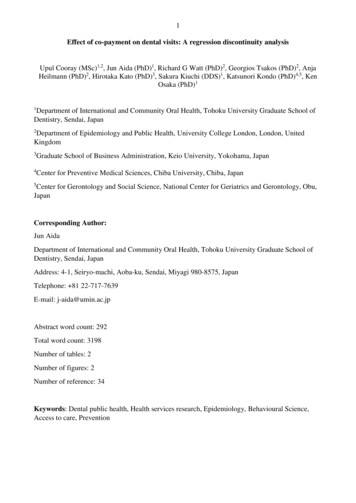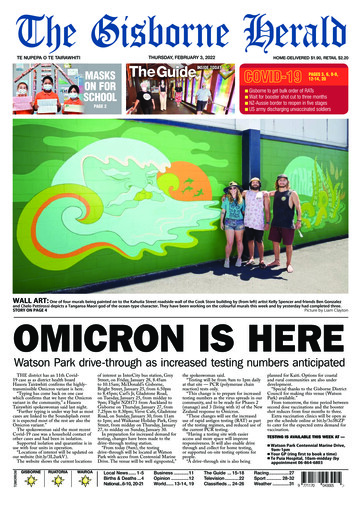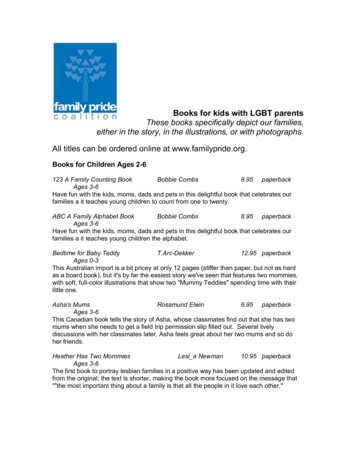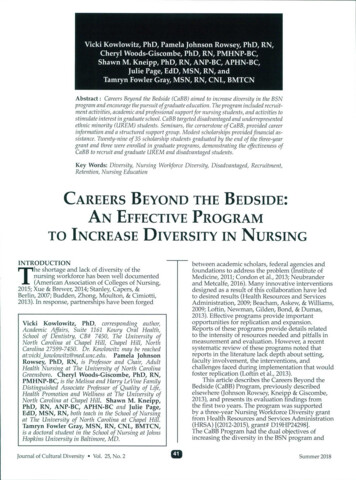
Transcription
Vicki Kowlowitz, PhD, Pamela Johnson Rowsey, PhD, RN,Cheryl Woods-Giscombe, PhD, RN, PMHNP-BC,Shawn M. Kneipp, PhD, RN, ANP-BC, APHN-BC,Julie Page, EdD, MSN, RN, andTamryn Fowler Gray, MSN, RN, CNL, BMTCNAbstract: Careers Beyond the Bedside (CaBB) aimed to increase diversity in the BSNprogram and encourage the pursuit of graduate education. The program included recruit ment activities, academic and professional support for nursing students, and activities tostimulate interest in graduate school. CaBB targeted disadvantaged and underrepresentedethnic minority (UREM) students. Seminars, the cornerstone of CaBB, provided careerinformation and a structured support group. Modest scholarships provided financial as sistance. Twenty-nine of 35 scholarship students graduated by the end of the three-yeargrant and three were enrolled in graduate programs, demonstrating the effectiveness ofCaBB to recruit and graduate UREM and disadvantaged students.Key Words: Diversity, Nursing Workforce Diversity, Disadvantaged, Recruitment,Retention, Nursing EducationC areers B eyond the B edside :A n Effective P rogramto I ncrease D iversity in N ursingINTRODUCTIONhe shortage and lack of diversity of thenursing workforce has been well documented(American Association of Colleges of Nursing,2015; Xue & Brewer, 2014; Stanley, Capers, &Berlin, 2007; Budden, Zhong, Moulton, & Cimiotti,2013). In response, partnerships have been forgedTVicki Kowlowitz, PhD, corresponding author,Academic Affairs, Suite 1161 Koury Oral Health,School o f Dentistry, CB# 7450, The U niversity ofN orth Carolina at Chapel Hill, Chapel Hill, NorthCarolina 27599-7450. Dr. Kowlowitz may be reachedat:vicki kowlowitz@med.unc.edu. Pamela JohnsonRowsey, PhD, RN, is Professor mid Chair, A d u ltHealth N ursing at The U niversity of North CarolinaGreensboro. Cheryl Woods-Giscombe, PhD, RN,PMHNP-BC, is the Melissa and Harry LeVine FamilyDistinguished Associate Professor o f Quality o f Life,Health Promotion and Wellness at The U niversity ofNorth Carolina at Chapel Hill. Shawn M. Kneipp,PhD, RN, ANP-BC, APHN-BC and Julie Page,EdD, MSN, RN, both teach in the School o f N ursingat The U niversity o f North Carolina at Chapel Hill.Tamryn Fowler Gray, MSN, RN, CNL, BMTCN,is a doctoral student in the School o f N ursing at JohnsHopkins U niversity in Baltimore, M D .Journal of Cultural Diversity Vol. 25, No. 2between academic scholars, federal agencies andfoundations to address the problem (Institute ofMedicine, 2011; Condon et al., 2013; Neubranderand Metcalfe, 2016). Many innovative interventionsdesigned as a result of this collaboration have ledto desired results (Health Resources and ServicesAdministration, 2009; Beacham, Askew, & Williams,2009; Loftin, Newman, Gilden, Bond, & Dumas,2013). Effective programs provide importantopportunities for replication and expansion.Reports of these programs provide details relatedto the intensity of resources needed and pitfalls inmeasurement and evaluation. However, a recentsystematic review of these programs noted thatreports in the literature lack depth about setting,faculty involvement, the interventions, andchallenges faced during implementation that wouldfoster replication (Loftin et al., 2013).This article describes the Careers Beyond theBedside (CaBB) Program, previously describedelsewhere (Johnson Rowsey, Kneipp & Giscombe,2013), and presents its evaluation findings fromthe first two years. The program was supportedby a three-year Nursing Workforce Diversity grantfrom Health Resources and Services Administration(HRSA) [(2012-2015), grant# D19HP24298].The CaBB Program had the dual objectives ofincreasing the diversity in the BSN program andSummer 2018
Figure 1. CaBB Align with Jeffrexj's NURS ModelStudent ProfileCharacteristicsTarget: Disadvantagedand UREMsStudent Affective FactorsAcknowledge & value students'cultural values & beliefsI ncrease self-efficacy &m otivationAcademic FactorsPre-nursing: Apply and beEncourage use o f resourcesNursing:adm itted to nursing schoolProfessional IntegrationFactorsGroup m e ntoring sessionsResearch m entoringCareer planningCelebrationsEnvironmental FactorsScholarshipsencouraging, as well as supporting, timely enrollmentinto graduate school, with the long-term goal toincrease the number of underrepresented ethnicminority (UREM) nursing faculty representing clinicaleducators, researchers and leaders in nursing. TheCaBB program incorporated strategies that addressedthe factors described in Jeffreys's (2012) NursingUndergraduate Retention and Success model (seeFigure 1).BACKGROUNDThe University of North Carolina at ChapelHill (UNC-CH) is a research-intensive universityand supports baccalaureate, masters, and doctoralprograms in nursing. The School of Nursing (SON)is part of the Health Affairs campus and requiresa separate application during the sophomore yearfor entry into the BSN program. North Carolina'sdemographics include approximately 24% AfricanAmerican, 4% American Indian, and 11% Hispanicresidents. In the year prior to our CaBB Program'sinception (2011-2012), the SON clearly did not matchthe demographics of the state with only 19.4%UREM students: African American (6.8%), AmericanIndians (0.6%), Hispanics (5%) and Multiethnic(6.8%) designations. To put our efforts in context, theuniversity also made efforts to increase recruitmentand support of UREMs and disadvantagedstudents. They launched the Carolina Covenant in2004 to address the educational and financial needsof students from low-income families. In fall 2010, theprogram admitted 558 scholars, 57% of who wereUREM students.The available data supported the need to increasethe diversity at the UNC-CH SON, in the nursingworkforce and in the state. The CaBB program wasdeveloped with the goal of achieving this aim. Inthe next section, we describe the CaBB program'sstructure and process evaluation, as shown in theLogic Model (Figure 2).Journal of Cultural Diversity Vol. 25, No. 2Academic OutcomesCareer planningTutoringParticipate in researchGraduateApply to graduate school(long-term goal)Psychological OutcomesI ncrease m otivation &persistenceIncrease satisfactionI ncrease feelings o f s u pp o rtPROGRAM COMPONENTS AND EVALUATIONRecruitment into CaBB ProgramThe resources needed for recruitment depend onthe ability to leverage existing campus organizationsand entities. We were fortunate that CaBB's goalswere congruent with a number of University wide initiatives at UNC-CH that provided majorassistance in undergraduate recruitment. Theseorganizations included the previously mentionedCarolina Covenant; the federally funded TRiOprogram, which includes the nationally knownMcNair Scholars Program, that provides resourcesand funding for disadvantaged UREM students toadvance through the academic pipeline; and theCarolina Firsts Program that supports first generationcollege students. The Minority Student RecruitmentCommittee (MRSC), a pipeline program comprisedof current UNC students and staff, was an excellentresource for recruitment because the committeehelps to cultivate a culture of inclusion, leadership,diversity, understanding, and success for UREMstudents University-wide. The committee targetsstudents who are pre-college to graduate level.Furthermore, the University campus has severalstudent organizations, including the Black StudentMovement, the Carolina Indian Circle, the CarolinaHispanic Association (CHispA), UNC-CH Chapterof the NAACP, and the Muslim Student Association,with whom we formed relationships.The Project Director and CaBB team met severaltimes a year with the leadership of these groups.Alliances were built to help identify strategies toengage and recruit students to explore nursing asa career through participation in CaBB Programactivities and to collaborate with these organizations'outreach activities. CaBB also worked collaborativelywith the SON's Offices of Student Services andMulticultural Affairs. CaBB's activities resulted in asubstantive addition to the SON's strategic plan torecruit and retain disadvantaged/ UREM students.Summer 2018
Figure 2. CaBB LOGIC MODELINPUTSStudent Pool UNCCommunityOUTPUTS by AUDIENCESHORTTERMINTERMEDIATEOUTCOMESAttendance at CaBBsessionsIncreased SONapplicationSON Applications TPre-Nursing------- Outreach to introduceHelp with SONapplicationExisting Resources Pre and Nursing SeminarsUNCScholarships CaBBTutoringUNCInteractiveSON* Satisfaction withseminarsReceive/usescholarshipsSatisfaction withtutoring/Increasedpass rate Accepted intoSON?Retention inSONTGraduationSONTCommunicationNursingMentorship forresearchFaculty and StaffSpecial Programs[Hillman)GRE andApplication Prep Satisfaction; work onprojects; attendconferences; co authors Apply to programs andreceive entry Tscores/Tapplication/TacceptanceApply to GraduateSONTE V A L U A T IO NMembers of these offices served as part of the CaBBteam and contributed to the project in variousways, including the review of process evaluationsand recruitment strategies. This article focuses ondescribing CaBB's strategies to recruit and retaindisadvantaged or UREM students to nursing school.Program Supports for Pre-Nursing StudentsNeeds Assessment. During Year 1 of the grant,an online survey was emailed to students (n 63)who had participated in any of the first four CaBBactivities. A major goal of the survey was to explorethese students' academic challenges and assess theiruse of university resources. The response rate was41% comprising 5 freshmen, 17 sophomores and 4"others".When asked what the most difficult under graduate courses were, most students listed thesciences. The responding sophomores listedChemistry (n 8) as the most difficult, withBiochemistry (n 4) being the second most oftenlisted. A question allowing multiple responses askedstudents to choose what would have been helpfulin overcoming the challenges/difficulties with theseJournal of Cultural Diversity Vol. 25, No. 2courses. Most of these 17 students chose "havingmore study time" (n 13). Additional responsesincluded "having better study skills in general"(n ll), "being able to study in a group rather thanalone" (n 8), and "having more access to a TA ortutor who could spend individual time" (n 8). Afollow-up question asked them to clarify reasons forlack of study time; the most frequent response wasthat they had too many demands on their time tomeet the requirements imposed by a full time courseload.It is important to note that UNC-CH has a numberof resources to assist undergraduates in achievingacademic success. These include a Writing Center, aCenter for Student Success and Academic Counseling,and a Learning Center. Many undergraduate classeshave teaching assistants (TAs). Ninety percent of thestudents (n 18) used TAs when available; 50%(n 10)used The Writing Center; 15% (n 3) used TheLearning Center, and 25% (n 5) indicated "Other" (3wrote in tutoring with two students having paid fortutoring; two went to the peer tutoring offered; onewent to the course's group supplemental instructionseminars; one talked to the course professor).Summer 2018
Table 1. Demographics of the students who attended CaBB seminarsProject Y e a r ! : 2012-2013Total(n 104)1Pre-Nursing(n 87)Project Y ear 2: 2013-2014Nursing Students(n 16)EthnicityBlackTotal(n 97)1Pre-Nursing(n 71)Nursing Students(n 25)n 97n 64n 2528 (26.9%)25 (28.7%)3(18.8%)29 (29.9 %)19(29.7%)7 (28.0%)Hispanic7 (6.7%)5 (5.7%)2 (12.5%)13(13.4%)9(14.1%)3(12.0%)American Indian orAlaska Native1 (1.0%)1 (1.1%)0.000012(11.5%)12(13.8%)0.07 (7.2%)6 (9.4%)1 (4.0%)3 (2.9%)3 (3.4%)0.03(3.1%)2(3.1%)1 (4.0%)White50 (48.1%)39 (44.8%)10(62.5%)36 (37.1%)24 (37.5%)9 (36.0%)Other3 (2.9%)32 (2.3%)1 (6.3%)9 (9.3%f4 (6.3%)4(16.0%)AsianAsian - UREMn 104n 87n 16n 96n 70n 25Female90 (86.5%)77 (88.5%)12 (75%)81 (84.4%)63 (90.0%)17(68.0%)Male14(13.5%)10(11.5%)4 (25%)15(15.6%)7(10%)8 (32.0%)20.74; 4.9019.56; 3.0027.13; 7.8622.73; 6.7221.46; 6.36325.52; 5.853n 99n 82n 16n 87n 63n 2424 (24.2%)21(25.6%)2 (12.5%)21 (24.1)16 (25.4%)5 (20.8%)---G enderAge (m ean; s.d)RuralFirst G enerationCarolina CovenantFinancial Award45n 2511 (44.0%)n 87n 16n 86n 60n 2523 (22.3%)23 (26.4%)022 (25.6%)17 (28.3%)5 (20.0%)---n 90n 64n 2536 (40.0%29 (45.3%)7 (28.0%)35 (38.9 %)17(26.6%)17(68.0%)Need-based award123n 6227 (43.5%)n 103Need-based loanD isadvantaged 4n 8838 (43.2%)42 (40.8%)a38 (43.7%)4 (25.0%)n 89n 64n 2567 (75.3%)45 (70.3%)22 (88.0%)The total reflects the number of unique forms submitted, not the number of attendees.Other 2012-2013: 2 American Indian & White; Pacific Islander/AsiaOther 2013-2014: American Indian/ Alaska Native & White (2); Black/white/Taino Indian; Caucasian/Asian; Israeli/middle eastern; Indian/White; Multi racial; Native American/White; Pacific Islander/AsianDisadvantaged was defined as at least one of the following indicated: first generation, Carolina Covenant, Need-based award, or from a rural county.Only Carolina Covenant and home-county were obtained in 2012-2013.We used the findings from this assessment toenhance the resources offered by the CaBB Programto improve the success of participating students. Forexample, the CaBB Program started an initiative toencourage the use of available resources on campus.In addition, the program created an incentive forstudents to track and submit reports of their useof resources. The information about time demandsmotivated the creation of work-study mentoringand the scholarship program, described later in thisarticle, to address this challenge.Academic Advising. To enhance the supportiveservices available for students, the CaBB programcollaborated with the pre-existing SON advisingsystem. One of the SON Academic Advisors wasa designated member of the CaBB project teamand attended all CaBB activities. This AcademicAdvisor meets one-on-one with pre-nursing studentsacross the university. As a registered nurse andfaculty member in the SON, the Academic Advisorprovides information about the curriculum andcourse requirements. In addition, she addresses otherimportant topics, such as career options in nursing,Journal of Cultural Diversity Vol. 25, No. 2optimal ways to navigate the course requirements,and suggestions on how to strengthen their app lication to the SON. During year 1, she met oneon-one with 65% of the CaBB pre-nursing students(n 51).Joint Supports for Pre-BSN and BSN NursingStudentCaBB Program Seminars. The cornerstonecomponent of the CaBB program was monthlyseminars designed to provide information aboutcareers in nursing and to form a structured supportgroup with peers and faculty. The CaBB facultymentors served as role models for students, sharingtheir journey, their passion, and their perspectivesabout various opportunities available in the nursingprofession. The mentors included faculty whowere diverse in age, ethnicity, gender, educationalbackgrounds, and nursing specialties. In addition,the CaBB project manager and evaluator attendedall seminars. In Project Year (PY) 1, the numberof students who registered for and attended theseminars ranged from 11-45 with a mean of 22.5.Summer 2018
Table 2. CaBB Seminar EvaluationsAverage percentage across survey items of respondents who rated the items positively: “Agree” or “Strongly Agree”on a 5-point Likert scale from “Strongly Agree” to “Strongly Disagree” 1Average percentage:# CompletedSeminar Topics# Attended“Agree” or “StronglyEvaluationsAgree”2012-2013 SeminarsStand Up and Lead for a Healthier Tomorrow1715100%Improving the Health of Individuals, Families,1817100%and Communities through Nursing ScienceEssay Writing Workshop: Putting Your Best473199.2%Foot Forward on Admission ApplicationsBridging the Gender Divide in Nursing242496.7%That Stereotype Hurts! Ouch!1714100%Resume Writing & Advancing Your Career139100%Research & Honors: Opportunities in Nursing191996.8%All 2012-2013 Sessions15512998.7%312998.9%3318100%3024100%Tips for Writing a Stellar Essay for NursingSchool Admission5841100%MSN, PhD, DNP: Understanding GraduateProgram Difference in Nursing383096.7%Ouch! That Stereotype Hurts!2622100%Bridging the Gender Divide in Nursing282596.0%All 2013-2014 Sessions24418998.6%2012-2013 SeminarsNursing in the 21st Century: EducationalOpportunities & Career PathwaysThe Life and Times of a UNC Chapel HillNursing Student: Almost everything you’d like toknow about the experience of being in the SONStudent Opportunities in Nursing Research:Advancing Science, Improving Lives12012-2013 Questions:The presenters clearly displayed expertise on their topicsThe presentation clarified . . . Statement of objectiveThe presentation provided interesting examples, tips, etc.The presentation increased my interest in pursuing acareer in nursing (sessions 1 and 2)The presentation was engaging and thought-provoking(sessions 4-8)Overall, this was a high quality programIn PY 2, the number of attendees was higher, witha range of 25-58 students per seminar and a meanof 34.9. These numbers are underestimates becauseregistration and signing-in were voluntary. Theworkshop on essay writing for admission applicationshad the most attendees both years. Table 1 shows thedemographics of participants in both years.The seminars were informative and interactive topromote discussion. Seminars were designed to (1)debunk myths about careers in nursing, (2) share thefaculty's passion for nursing, (3) present the diverseroles and career paths for nurses, (4) explore issuesof diversity, (5) support students' success in theJournal of Cultural Diversity Vol. 25, No. 22013-2014 Questions:The presenters clearly displayed expertise on topicsThe presentation was informative, engaging and thoughtprovokingOverall, this was a high quality programapplication process and (6) create a safe communityand opportunities for mentoring. Table 2 shows theseminar topics and evaluation results for PY 1 andPY 2. Seminars were modified in PY 2 to facilitatecontinued attendance and engagement of studentswho had attended the seminars the previous year(n 26).Each year students were asked to completea demographic questionnaire the first time theyattended a seminar and to sign in at each seminar.Students were also asked to complete an evaluationat each seminar. This allowed the program to trackparticipation and evaluate and modify each seminarSummer 2018
based on the feedback. The protocol for this processwas submitted to the UNCIRB for review and wasdetermined to be exempt. The evaluation componentincluded standardized statements that asked studentsto rate their degree of agreement using a 5-pointLikert scale from l strongly disagree to 5 stronglyagree. Students were also invited to comment on thestrengths and improvements needed and suggesttopics for future seminars.The seminar evaluations were overwhelminglypositive in both years. A thematic text analysis wasused to analyze the students' comments on thestrengths and improvements needed. After readingthrough all the responses, categories were createdfrom the themes that emerged. Identification ofthe themes were done independently by one of theauthors and two work-study students, and thendiscussed to eliminate bias. Then each comment wascoded. In 2012-2013, there was a total of 94 commentsfor all the seminars, with an average of 13.4 (range9-25). In 2013-2014, there was total of 140 comments,with an average of 20.0 (range 12-34). Besides thecommon general statements that were reflected in theratings, like "[very] interesting", "[very] informative","learned a lot", the following identified themessupported the goals of creating a safe, supportivecommunity for the students and empowering themwith information to support their decision to becomea nurse and succeed in the process: (1) commentsabout the atmosphere: welcoming, approachablefaculty, informal setting, dialogue / interactive quality;inspiring; (2) hearing personal stories; (3) clarificationof the profession and the types of roles for nurses;and (4) discussions were thought-provoking. Bothyears, the seminar on "Tips for Writing a StellarEssay for Nursing School Applications" had the mostcomments. Besides commenting that the programwas helpful and informative, many students (7 in PY1and 14 in PY 2) commented that hearing from currentnursing students about their personal stories and theprocess was very helpful.MentoringGroup Mentoring. The seminars describedabove, designed to recruit and mentor UREM anddisadvantaged students, provided support for pre nursing students and nursing students in a veryinformal setting. These seminars served as an avenuefor faculty to demystify stereotypes about nursingwhile at the same time informing students aboutthe diverse roles and career paths for nurses. Thegroup mentoring seminars also allowed studentsopportunities to meet nursing faculty in an informalsetting, creating a safe community and opportunitiesfor mentoring fKneipp et al., 2014).Peer Mentoring. The CaBB program also offeredpeer mentoring through the Association of NursingStudents (ANS), which also encouraged participationin the professional association. Having contactwith faculty and students outside of class has beenidentified as a significant factor for retention (Benda,1991) and that students with a higher perception ofsupport are less likely to withdraw from their nursingprogram (Shelton, 2003; Jeffreys, 2012).Journal of Cultural Diversity Vol. 25, No. 2Work-Study Mentoring. The CaBB mentorscreatively developed a strategy to provide oneon-one mentoring for pre-nursing and nursingstudents. The mentors hired CaBB students forwork-study positions to expose students to nursingresearch. This allowed students to have one-onone mentoring as well as opportunities to becomea member of a research team. This initiative was inalignment with the goal of encouraging UREM/disadvantaged students to pursue nursing researchand graduate studies. By PY 3, eight students wereinvolved in research activities such as co-coordinatingresearch projects, performing literature reviews,creating hiohehavioral data acquisition protocols,participating in data collection, and co-authoringposter presentations and manuscripts. Because of thisexperience, one UREM student participated in theHonors program and had been admitted to a graduateprogram in nursing.ScholarshipsOne of the objectives of the CaBB program wasto provide financial support to help students achievesuccessful academic outcomes. Thus, CaBB providedneed-based scholarships for disadvantaged studentsparticipating in the CaBB program. Criteria andapplications for CaBB scholarships were developedand disseminated at CaBB seminars and posted on theCaBB Sakai site. Two faculty members and the ProjectManager reviewed applications for eligibility andrated the quality of the essays to determine awardees.Ten CaBB scholarships were awarded, five pre nursing and five nursing students, in 2012-2013. In2013-2014, there were 23 awardees, five pre-nursingand 18 nursing students. Seven students receivedscholarships both years. All 18 nursing studentswho received scholarships graduated. Seven of the10 pre-nursing students were admitted. All students(n 26) were disadvantaged; 11 were Black, six wereHispanic/Latino, two were multiracial (NativeAmerican and Caucasian), two were Asian, and fivewere Caucasian. Among this group, eight were men.A survey was sent to the PY 1 cohort to determinehow the CaBB Program and scholarship awardsassisted them in meeting their goals. Regarding thescholarship awards, most commented that it helpedthem reduce the number of hours they had to workor reduced stress on either them or their parents. Forexample, students shared that the award "allowedmore time to study and get better grades"; "I wasthen able to volunteer as well as work on an honorsproject"; and "It allowed me to take the necessaryclasses during the summer."Supports for Students After Entry into the NursingProgramTutoring. After the first CaBB cohort wasadmitted into the Nursing program, the ProjectDirector worked with the course coordinators ofPathophysiology and Pharmacology, the mostchallenging first-year nursing courses, to offertutoring. The tutors offered both face-to-face grouptutoring sessions and online tutoring using the SakaiCourse Management System. Tutoring sessionsfor Pathophysiology were well attended with 39Summer 2018
and 30 individual students attending multipletutoring sessions in spring and summer of 2013,respectively. Only 18 students signed-in for tutoringin Pharmacology in fall 2013 and 21 students inspring 2014. Only 21 students completed the onlineevaluation of the tutoring sessions. Ninety percentof those students rated the tutoring Very Helpful orHelpful on a 4-point Likert scale from Very Helpful toNot at All Helpful. Students commented that they likedreviewing practice questions; it helped them to focuson key topics; and the tutor was able to explain therationale behind the answers and breakdown complexconcepts into manageable pieces.RESULTS A N D DISCUSSIONThe success of the CaBB program was reflectedin the attendance of over 100 students at the groupmentoring seminars each of the three years of thegrant, the percent of CaBB students who appliedand were admitted to the SON, and the successfulgraduation of the nursing students who receivedscholarships. In addition, of the seven CaBBscholarship graduates who responded to a follow-upsurvey in spring 2016, three were already in graduateprograms and the other four were planning to applyto graduate school in the next 2-3 years.In 2012-2013, 102 UREM students applied to theSON and 17 students (16.7%) were admitted. Thatsame year, 25 students involved with CaBB pre-entryactivities applied and 18 (72%) were admitted. Eightof those admitted were UREM students: five wereBlack, one was Hispanic, one was Native American,and one was Asian. The percent of UREM studentsparticipating in CaBB that applied and were admittedwas 87.5%. One of these students was admitted to theHillman Scholars Program in Nursing Innovation,which puts students on a path that culminates inPhD degree in nursing. In 2013-2014,19 of the CaBBparticipants applied and 15 (79%) were admitted tothe BSN program. Of the 15 admitted, eight wereUREM students: five were Black, one was Hispanic,and two were multi-racial. The percent of UREMstudents participating in CaBB that applied and wereadmitted was 80%.In 2014-2015, 38 CaBB participants applied foradmission to the SON and 27 (71.1%) were admitted.Of the 27 admitted, five were UREM students:two were Black, one was Hispanic, and two weremulti-racial: Hispanic/White and Black/White. Thepercent of UREM students participating in CaBBthat applied and were admitted was 55.6%. Duringthe three years of the grant, 54 scholarships wereawarded to 35 students. By the end of the grant, 29 ofthe 35 scholarship students had graduated and twopre-nursing students had been admitted to the classstarting May 2016.These results demonstrate support of Jeffreys's(2012, 2015) Nursing Undergraduate Retention andSuccess (NURS) model that presents a framework forexamining the variables that affect undergraduateand graduate student retention and success. Jeffreys(2015) suggests that the aim should be more thanachieving minimum standards (i.e. graduation;pass rate on licensing exam) but should include"achieving personal satisfaction and reaching be Journal of Cultural Diversity Vol. 25, No. 2yond the benchmarks to achieve one's potentialand then strive for more." (p. 425). According to themodel, retention decisions, persistence, and optimaloutcomes are based on the interaction of the followingfactors: (1) student profile characteristics (e.g., age,race/ethnicity, and language); (2) student affectivefactors (e.g., cultural values and beliefs, self-efficacy,and motivation); (3) academic factors (e.g., studyskills and time spent studying); (4) environmentalfactors (e.g., finances, hours of employment,family responsibilities, transportation, and outsideencouragement); and (5) professional integrationfactors (e.g., support of faculty and classmates,professional memberships). Jeffreys (2012) concludedthat attention to these factors resulted in positiveacademic and psychological outcomes.The CaBB program included intentional strategiesthat addressed Jeffreys's factors (see Figure 1).Academic factors were addressed through strategiessuch as career advising, tutoring and encouraging theuse of campus resources (e.g., the Learning Centerand Writing Center). Scholarship awards addressedthe environmental factor of financial constraints.Affective factors were addressed through groupand individual mentoring. Professional integrationincluded research mentoring and attending orpresenting at professional meetings.The group mentoring seminars also provided thecore support for the professional integration factor.The seminars were the structured thread throughoutthe program. It became the ingredient that keptstudents engaged and the students who attendedbonded with each other and with the faculty, forminga "community" of support and encouragement. Theresults reflected in the analysis of the commentson the students' seminar evaluations support thesignificance of the professional integration factors ofthe NURS model for the recruitment and retentionof UREM and disadvantaged pre-nursing, nursing,and graduate students. As Jeffreys states (2015),"Professional integration factors are factors thatenhance students' interaction with the social systemof the college environment within the context ofprofessional socialization and career development. . It is also proposed that professional integrationfactors have the greatest power of optimizingoutcomes aimed at discovering and achieving one'spotential." (p. 429)The supportive and committed CaBB faculty andstaff created a welcoming community to learn aboutthe various roles of nurses and different career paths,to celebrate diversity, and to create a safe environmentto share and ask questions. The students' commentsdemonstrated that CaBB
School of Dentistry, CB# 7450, The University of North Carolina at Chapel Hill, Chapel Hill, North Carolina 27599-7450. Dr. Kowlowitz may be reached at:vicki_kowlowitz@med.unc.edu. Pamela Johnson Rowsey, PhD, RN, is Professor mid Chair, Adult Health Nursing at The University of North Carolina Greensboro.
